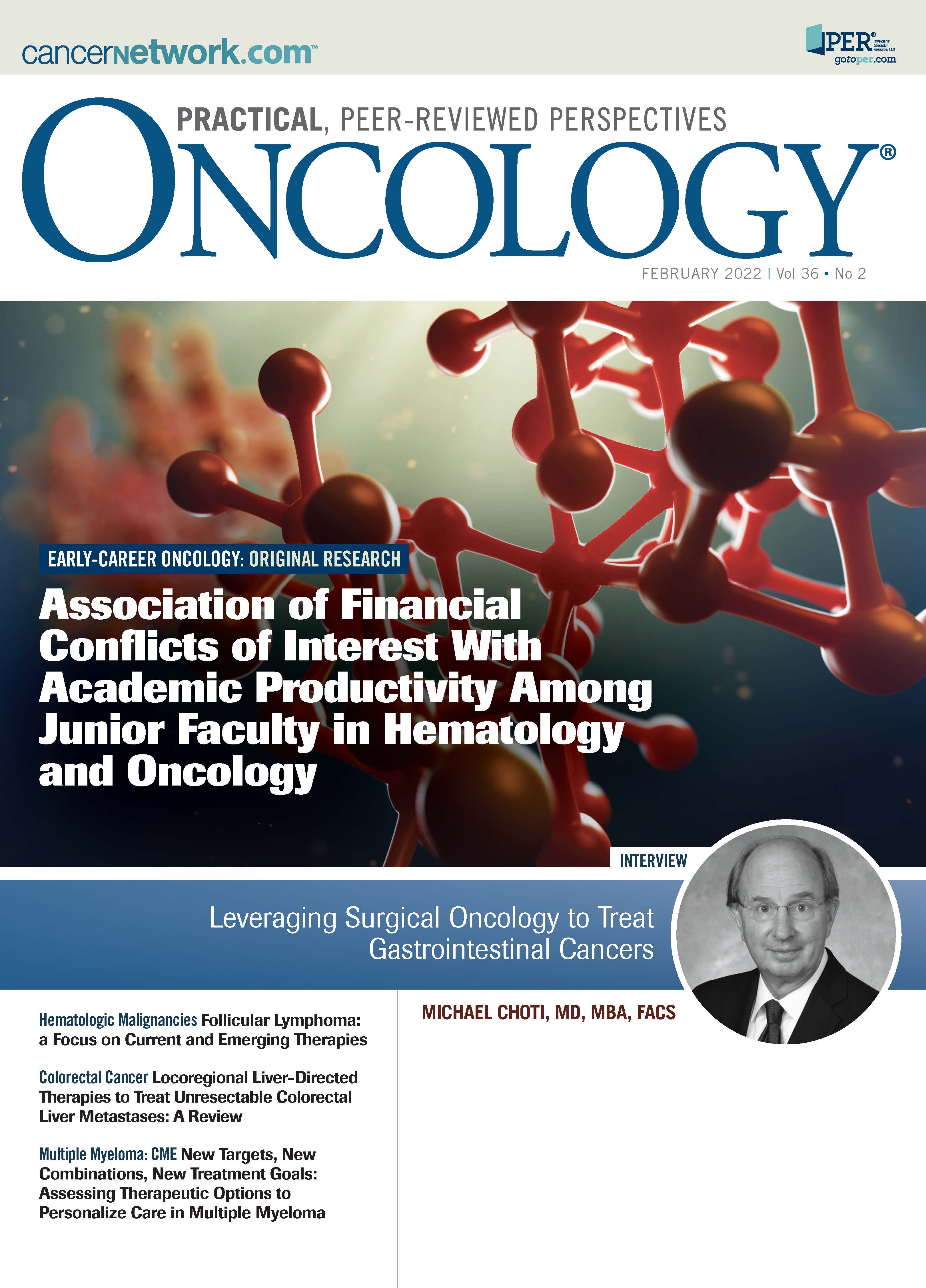Academic Promotion and Oncology Drug Development: Role, Responsibilities, and Integrity
Nora Janjan, MD, MPSA, MBA, gives her perspective on oncology drug development through academic promotion, as an accompaniment to the article titled "Association of Financial Conflicts of Interest With Academic Productivity Among Junior Faculty in Hematology and Oncology" published in the journal ONCOLOGY.
Conflicts of interest ultimately focus on roles, responsibility, and integrity. Drug development, especially in oncology, is a complicated process that involves many individuals and entities. Each makes a specific contribution to the process and provides redundant oversight. This redundancy is intended to minimize bias and risk while evaluating benefit to the patient. At any stage of their career, those responsible for the lives of patients must have unquestionable credibility and integrity.
Every sector of medicine has a role in the process of evaluating a drug, both before and after regulatory approval. Pharmaceutical companies develop molecules, navigate regulatory pathways, fund clinical trials, manufacture the drug, and ultimately distribute the medication to pharmacies. Academic oncology centers conduct clinical trials to confirm the safety and efficacy of a drug, both before and after FDA approval. Health economics and outcomes research (HEOR) is increasingly being performed by health care policy institutes within academia and independent entities. Clinical research is scrutinized through peer review by institutional review boards (IRB), program committees of organized medicine, and medical journals before publication.
Conflicts of interest (COI) for every physician and entity come down to integrity. Research integrity, as defined by the National Institutes of Health (NIH), involves honesty, accuracy, efficiency, and objectivity.1 Integrity also requires transparency, especially regarding financial and other personally beneficial relationships.2 Beyond investigators, the NIH also has strict COI rules for reviewers of NIH applications and contract proposals.3
The concerns regarding COI generally focus on the pharmaceutical firm and the faculty member. Faculty, in an American Society of Clinical Oncology audit of its journal authors, were found to be thorough in disclosing research and consulting relationships.4 Within an academic construct, the institution’s legal and IRB approvals must first be obtained before a clinical trial can only be conducted. The academic institution is ultimately responsible for approving, monitoring, and managing the clinical trial and faculty COI disclosures.
The authors in this study emphasize that clinical research would be highly restricted if it were only funded by the NIH given its limited scope of research and budget. Within this survey, only 15% of these junior faculty had NIH funding.5 Approximately one-third of all clinical trials registered on ClinicalTrials.gov are industry sponsored.
With long-standing experience in the conduct of clinical trials, academic oncology centers provide specific benefit to patients. Patients often seek care at academic institutions to participate in clinical trials and receive cutting-edge therapy. Before FDA approval, faculty physicians within an academic institution gain experience with an agent, and closely monitor and treat adverse events. Outside of academic centers, few oncology practice centers have a sufficient health care infrastructure that could safely conduct (especially early phase) clinical trials for pharmaceuticals prior to FDA approval.
Through the conduct of these clinical trials, junior academic oncology faculty gain specialized expertise that can direct their research careers. Practice-influencing results from these clinical trials, after peer review, are presented within plenary sessions or as keynote presentations within high-profile annual specialty society meetings to inform oncologists of the outcomes. Publication of the clinical trial results in high-impact factor journals subsequently are included in regulatory filings and influence clinical practice guidelines that broadly expand patient access to the therapeutic.
The encouraging finding from this study is that a high percentage of junior faculty are given opportunities to conduct significant clinical trials that allow career advancement, which supports a future pipeline of academic oncologists. Although the number of women enrolling in medical school now exceeds men, the number of women among medical oncology academic faculty is only 37.1%.6,7 In this study, women accounted for 45% of the 230 young academics from the top 10 cancer centers who were involved with industry-sponsored studies, suggesting recognition of the continued need for mentorship.
Given limited NIH funding opportunities, many junior faculty members launch successful academic careers by conducting industry-funded clinical trials. Potential COI issues are managed and monitored through redundancies that exist within and outside of academic institutions. Contrary to COI concerns, involvement of junior faculty in conducting industry-funded clinical trials is crucial to maintaining the pipeline of academic oncologists to investigate future therapeutic advancements.
Janjan is a senior fellow in health care policy at the Goodman Institute of Dallas, Texas, which is headed by economist John Goodman, PhD, the father of health savings accounts. She is also the chief medical officer of STATinMED Research, a for-profit company that conducts HEOR for various entities including pharmaceutical firms.
References
1. Steneck NH. ORI introduction to the responsible conduct of research. Office of Research Integrity. Accessed January 21, 2022. https://ori.hhs.gov/ori-introduction-responsible-conduct-research
2. Financial conflict of interest. National Institutes of Health Grants & Funding. Updated January 10, 2020. Accessed January 17, 2022. https://grants.nih.gov/grants/policy/coi/index.htm
3. NIH conflict of interest rules: information for reviewers of NIH applications and R&D contract proposals. National Institutes of Health/Office of Extramural Research. October 2018. Accessed January 17, 2022. https://grants.nih.gov/grants/peer/NIH_Conflict_of_Interest_Rules.pdf
4. Garrett-Mayer E, Kaltenbaugh MW, Spence R, et. al. Discrepancies in financial self-disclosures and open payments reporting among authors of clinical oncology research studies. J Clin Oncol. 2020;38(5):480-487. doi:10.1200/JCO.19.02467
5. Association of financial conflicts of interest with academic productivity among junior faculty in hematology and oncology. Oncology (Williston Park). 2021
6. More women than men enrolled in U.S. medical schools in 2017. News release. Association of American Medical Colleges. December 17, 2017. Accessed January 18, 2022. https://www.aamc.org/news-insights/press-releases/more-women-men-enrolled-us-medical-schools-2017
7. Chowdhary M, Chowdhary A, Royce TJ, et. al. Women’s representation in leadership positions in academic medical oncology, radiation oncology, and surgical oncology programs. JAMA Netw Open.2020;3(3):e200708.doi.10.1001/jamanetworkopen.2020.0708
